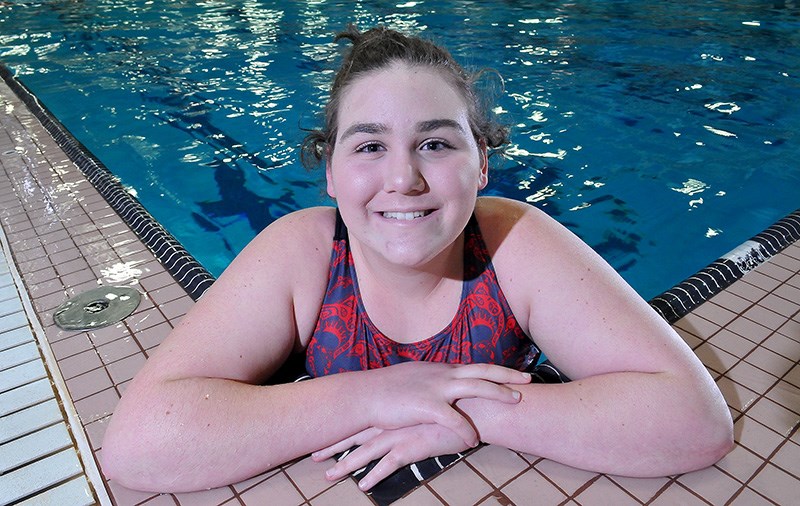Stephanie Papillo loves synchronized swimming.
She loves the spangly, glittering costumes she gets to wear. She loves going to the pool 10 or 11 hours a week to practice with her teammates on the BC Aquasonics. She especially loves bettering them in their underwater warmups to see who can hold their breath the longest.
But when it came time to gel their hair and test their preparation at competitions, Stephanie had to watch from the pool deck.
That’s because the 14-year-old Coquitlam teen has a non-verbal learning disability and there’s no accommodation in the rules of competitive synchronized swimming to allow athletes with and without disabilities to compete together on the same team. Stephanie could be part of the team, but at meets she had to perform her own routine solo.
Not anymore.
In February, all five Aquasonics — including Stephanie — swam together as a mixed ability team at a meet in Surrey. In April they’ll compete at the Lower Mainland regionals in Richmond, and then at the Jean Peters provincial championships in Surrey in May.
Synchro BC president RaeAnne Rose said it may be a world’s first.
For Stephanie, “it was kinda cool.”
For her mom, Leah, the moment Stephanie strode across the deck and jumped into the water with her teammates meant another barrier had fallen.
“I was so proud,” she said. “You could see her beaming, responding to the crowd.”
Melinda Markser, an adaptive coach who’s an advisor to Synchro BC, said the creation of mixed ability competitive categories in the sport is a huge step toward inclusion for all sports.
“Imagine if we had mixed ability categories in other team sports and in higher levels of competition,” she said. “That would truly be building a global inclusive environment.”
Of course becoming a pioneer wasn’t anywhere on Stephanie’s radar when she first jumped into the pool in the wake of her older sister, Mikayla, who was also a synchronized swimmer.
Stephanie’s disability, which her mom said causes her to interpret everything she’s told — like a coach’s instruction — very literally and also makes it a struggle for her to interact socially, presented some challenges for learning how to swim. If she was told to swim a stroke with her arm, she would do exactly that and nothing more.
But Stephanie persisted and soon enough she was training and entering races with the Coquitlam Sharks. Five years ago she joined the club’s recreational synchro team and her disability was no problem at their meets.
It was only as the girls got older and the competitions more serious when Stephanie’s disability presented a challenge to the aspirations of moving up the competitive latter.
A solution to allow Stephanie to be part of her new Aquasonics’ team, yet compete as an individual, was worked out. In fact, she even became the first athlete with a disability from B.C. to go the national synchronized swimming champions where she earned a gold medal.
Still, having to watch her teammates perform the routines she had practised with them for so many hours, hurt.
“It felt kinda lonely,” Stephanie said. “I wanted to be on a team.”
While Synchro BC’s new program allows that to happen for provincially-sanctioned competitions, it hasn’t yet extended to other provinces or nationally. That means Stephanie will have to swim solo again at the 2018 Espoir Canadian championships that will be held in Surrey May 29 to June 3.
“It’s all about having to change policy in order for this to happen,” Leah Papillo said. “Stephanie is willing, so how do we get her to the next level.”
Until those changes happen, Stephanie said she’s enjoying synchro more than ever. She’s become a better swimmer. Her teammates invite her to sleepovers, parties and adventures to escape rooms.
Her mom said she’s become more confident.
Her coach, Erin Williams, said Stephanie has become a leader, a role model to her teammates who are one age category younger. And she’s helped her become a better coach because she’s had to concentrate on properly communicating all her instructions.
“I”m happier,” Stephanie said. “I have more friends. I’m not alone.”



